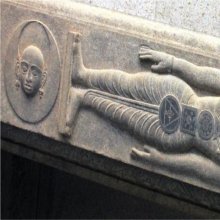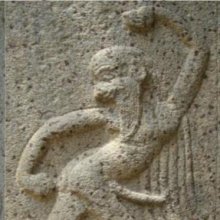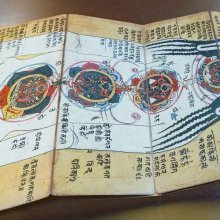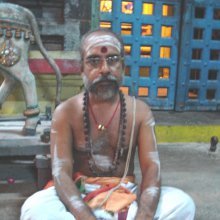Muladhara, Mūlādhāra, Mula-adhara: 10 definitions
Introduction:
Muladhara means something in Hinduism, Sanskrit, Marathi, Hindi. If you want to know the exact meaning, history, etymology or English translation of this term then check out the descriptions on this page. Add your comment or reference to a book if you want to contribute to this summary article.
Alternative spellings of this word include Muladhar.
Images (photo gallery)
In Hinduism
Yoga (school of philosophy)
Source: Chakras: HinduismMūla = Root, Origin, Essence; Ādhāra = Basis, Foundation. Just as the womb of the mother creates the basic requirement for the growth of the embryo, the Mūlādhāra Chakra forms the basis and the starting point for our spiritual development. It is the foundation from which we climb the ladder of the Chakras; the root from which we receive the nourishment for our spiritual development. For this reason, and because it lies at the lowest point of the spinal column below the Coccyx, it also bears the name “Root Chakra”.
Kundalinī Shakti (spiritual energy) has its roots in the Mūlādhāra Chakra, but it is in a deep, motionless sleep. When we awaken this slumbering potential that lies within the Mūlādhāra Chakra we are able to work our way towards the light of knowledge and attain the fruit of Self-Realisation.

Yoga is originally considered a branch of Hindu philosophy (astika), but both ancient and modern Yoga combine the physical, mental and spiritual. Yoga teaches various physical techniques also known as āsanas (postures), used for various purposes (eg., meditation, contemplation, relaxation).
General definition (in Hinduism)
Source: WikiPedia: HinduismMuladhara (Sanskrit: मूलाधार, Mūlādhāra) is one of the seven primary chakras according to Hindu tantrism. It may be represented by the color red, but its root square form is usually yellow.
Muladhara is said to be located near the basal end of the spinal column in the vicinity of the coccygeal plexus beneath the sacrumit, while its kshetram, or superficial activation point, is located on the perineum.
Appearance: Its symbol is a yellow, square lotus, surrounded by eight shining spears on the sides and corners with four red petals. The deity of this region is Indra, who is yellow in color, four-armed, holding a vajra and blue lotus in his hands. He is mounted upon the white elephant Airavata, who has seven trunks, denoting the seven elements vital to physical functioning. Occasionally, instead of Indra, the deity may be Ganesha, with coral orange skin, wearing a lemon yellow dhoti with a green silk scarf draped around his shoulders. In the three hands he holds a laddu, a lotus flower and a hatchet, and the fourth is raised in the mudra of dispelling fear.
The seed mantra syllable is लं laṃ. Within the bindu, or point that forms a part of the letter, just above it, is Brahma, who is deep red, with four faces and four arms, holding a staff, a sacred vase of nectar, a Jappa Mala, and making the gesture of dispelling fear. Alternatively, instead of the staff and Jappa mala, he may be holding a lotus flower and the sacred scriptures. He is seated on a swan. A goddess called Dakini is his shakti. She is beautiful, with three eyes and four arms. Dakini is usually depicted shining red or white, holding a trident, a skulled staff, a swan, and a drinking vessel, and is seated on a swan. Instead of a swan and drinking vessel, at times she holds a sword and a shield.
Muladhara is the base from which the three main psychic channels or nadis emerge: the Ida, Pingala and Sushumna. It is also believed that Muladhara is a subtle abode of the Hindu God, Ganapati. And in the highest revered prayer for Ganapati, the Ganapati Atharvashirsha, it is mentioned that 'one who worships Lord Ganapati would easily grasp the concept and realize Brahman'.
Function:
The transcendental basis of physical nature, and is considered the "root" or "foundation" chakra, is known as Muladhara. Kundalini awakening begins here. It is also known as the seat of the "red bindu" or subtle drop, which rises up to the "white bindu" in the head to unite the female and masculine energies, or Shakti and Shiva. It is associated with the element of earth, the sense of smell and the action of excretion.
"By meditating thus on Her who shines within the Muladhara Chakra, with the luster of ten million Suns, a man becomes Lord of speech and King among men, and an Adept in all kinds of learning. He becomes ever free from all diseases, and his inmost Spirit becomes full of great gladness. Pure of disposition by his deep and musical words, he serves the foremost of the Devas."
Languages of India and abroad
Marathi-English dictionary
Source: DDSA: The Molesworth Marathi and English Dictionarymūlādhāra (मूलाधार).—m (S) The original foundation, basis, ground, source.
Marathi is an Indo-European language having over 70 million native speakers people in (predominantly) Maharashtra India. Marathi, like many other Indo-Aryan languages, evolved from early forms of Prakrit, which itself is a subset of Sanskrit, one of the most ancient languages of the world.
Sanskrit dictionary
Source: DDSA: The practical Sanskrit-English dictionaryMūlādhāra (मूलाधार).—
1) the navel.
2) a mystical circle above the organs of generation; मूलाधारे त्रिकोणाख्ये इच्छाज्ञानक्रियात्मके (mūlādhāre trikoṇākhye icchājñānakriyātmake).
Derivable forms: mūlādhāram (मूलाधारम्).
Mūlādhāra is a Sanskrit compound consisting of the terms mūla and ādhāra (आधार).
Source: Cologne Digital Sanskrit Dictionaries: Shabda-Sagara Sanskrit-English DictionaryMūlādhāra (मूलाधार).—n.
(-raṃ) The navel.
Source: Cologne Digital Sanskrit Dictionaries: Monier-Williams Sanskrit-English Dictionary1) Mūlādhāra (मूलाधार):—[from mūla > mūl] n. Name of a mystical circle situated above the generative organs, [Pañcarātra; Ānanda-laharī]
2) [v.s. ...] the navel, [Rāmatāpanīya-upaniṣad]
[Sanskrit to German]
Sanskrit, also spelled संस्कृतम् (saṃskṛtam), is an ancient language of India commonly seen as the grandmother of the Indo-European language family (even English!). Closely allied with Prakrit and Pali, Sanskrit is more exhaustive in both grammar and terms and has the most extensive collection of literature in the world, greatly surpassing its sister-languages Greek and Latin.
Hindi dictionary
Source: DDSA: A practical Hindi-English dictionaryMūlādhāra (मूलाधार) [Also spelled muladhar]:—(nm) one of the six ganglions in the human body (according to [haṭhayoga]); also called [mūlādhāra cakra].
...
Kannada-English dictionary
Source: Alar: Kannada-English corpusMūlādhāra (ಮೂಲಾಧಾರ):—
1) [noun] a main support, prop of a structure organisation.
2) [noun] the basic principle of a development, movement, philosophy, rtc.
3) [noun] the depression in the centre of the surface of the abdomen indicating the point of attachment of the umbilical cord to the foetus; the navel.
4) [noun] the lowest of the six mystic circles in human body, supposed to be at between anus and the genital organ.
Kannada is a Dravidian language (as opposed to the Indo-European language family) mainly spoken in the southwestern region of India.
See also (Relevant definitions)
Partial matches: Adhara, Mula.
Starts with: Muladharacakra, Muladharachakra, Mulataram.
Full-text (+20): Shatcakra, Muladhar, Cakra, Kundalini, Agnikhamda, Shadadhara, Sarpa, Svadhishthana, Kariyakevalam, Sushumna, Tatpurusha, Nadi, Vital air, Nadicakra, Mulataram, Pinda, Bandhana, Samira, Asha, Ashapasha.
Relevant text
Search found 28 books and stories containing Muladhara, Mūlādhāra, Mula-adhara, Mūla-ādhāra; (plurals include: Muladharas, Mūlādhāras, adharas, ādhāras). You can also click to the full overview containing English textual excerpts. Below are direct links for the most relevant articles:
Thirty minor Upanishads (by K. Narayanasvami Aiyar)
Hamsa Upanishad of Shukla-Yajurveda
Varaha Upanishad of Krishna-Yajurveda, Chapter V
Shat-cakra-nirupana (the six bodily centres) (by Arthur Avalon)
Cidgaganacandrika (study) (by S. Mahalakshmi)
Verse 140 [Ṣaṭcakra Mānasa Sthiti] < [Chapter 3 - Third Vimarśa]
Verse 101 [Nāda’s path] < [Chapter 3 - Third Vimarśa]
Verse 227-228 [Sahasrāra and shower of Somarasa] < [Chapter 4 - Fourth Vimarśa]
Sivaprakasam (Study in Bondage and Liberation) (by N. Veerappan)
Karya Avasthas < [Chapter 3 - Understanding the Self]
Means of release in Shaiva Siddhanta—Importance of Preceptor < [Chapter 6 - Means to Release]
The Brihaddharma Purana (abridged) (by Syama Charan Banerji)
Shakti and Shakta (by John Woodroffe)
Chapter XXIX - Kuṇḍalinī Śakti (Yoga) < [Section 4 - Yoga and Conclusions]
Chapter XXIV - Śakti as Mantra (Mantramayi Śakti) < [Section 3 - Ritual]
Chapter XXIII - The Psychology of Hindu Religious Ritual < [Section 3 - Ritual]
Related products





